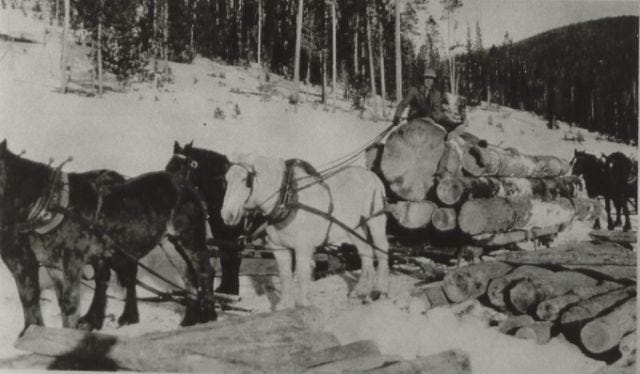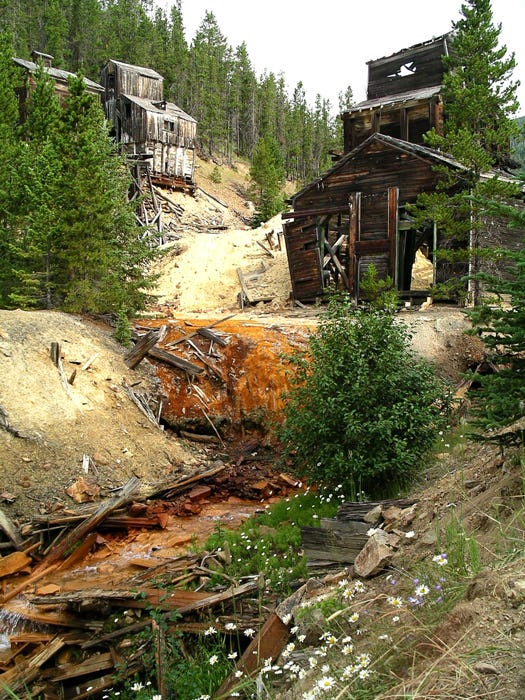Gold Needs Wood
I’ll begin where I left off last week -
GOLD
Gold was found in Colorado in 1858, the subsequent human invasion changed the mountain landscape, quite literally. Well, of course, gold is really useful, you can, uh, well, it’s pretty, and there’s, uh, I mean…
Here’s the reality - Gold is rare, so rare that if all of the world’s current found-gold were to be melted together, it would only fill an Olympic-sized swimming pool. Because of this, it has been used as a representation of wealth. It does not tarnish, break down, or deteriorate. It is malleable, hefty, and has a strong visual appeal. As a result, it is mainly used as a basis for monetary exchange. About 40% of gold is made into jewelry, and it has been used in dentistry for millennia (yes, really!). More recently, we have found uses for the unique properties of gold’s electrical conduction and reflectivity, making it valuable in electronics and space exploration. But those final two are only from the last 80 years or so. In the mid-1800s, finding gold simply meant finding ‘free’ money. The value of gold for the average person is more a matter the idea of the wealth and status it represents, than the practical use for their benefit. Gold kind of hijacks the brain and for many people struggling to make it in this new and rapidly changing country, the thought of reaching in a creek and picking up an opportunity for a new life was very appealing and worth the risk of the trip.
So, it’s 1859 and you’ve traveled from the eastern United States, here to find your fortune in gold. Let’s get started. It gets chilly in Colorado at night, and to get warm you’d best find a fire to get near, and for a fire for warmth you need wood. You’ve gotten hungry and to cook your food on a fire you’ll need wood. You head out the next morning to find your fortune and you’re told you need some tools; shovels, picks, sluice, and sifter boxes, and the tool handles and boxes are made of wood. You find a room in a new town with a brand new boarding house and the whole thing is built of wood. You join a company working together to dig a mine that uses wooden flumes, and wooden railed carts that ride on rails on top of wooden railroad ties. The interior of the mines are supported by wooden beams and the tools, with wooden handles, are stored in a shed made of wood, and the manager’s office is in a building made of wood. In time, the railroad lines are built and they ride on rails laid on wooden ties, and some of the steam engines burned wood.
You get the picture. The really useful material is wood. When structures are made of wood and every meal is cooked on a wood fire, and nearly everything is made with wood (no plastic then), you are going to need to take some trees down. Hoo boy, do we got some mighty big trees here to use!
At this time, the abundant forests they saw were ‘old growth forests’ with some trees over a thousand years old and trunks 3-6 feet across. The Ponderosa Pines were more spread out and not densely packed, but they were nearly twice the size of today’s Ponderosa Pines. Trees were most often cut with a 2-man saw and cut about 24” up from the ground leaving the tell-tale stump behind. Horses would drag the trees on


skids to the nearest sawmill. The towns would have small and family-run sawmills, cutting timber, and processing boards for sale right on site. It was dangerous and back-breaking work, but the sawmills couldn’t get the wood to the miners fast enough. Virtually no wood was exported out of Colorado as the largest demand was right here. In time, Colorado had to import wood to meet the demand.
So, who were the ones who made the money to build a new life? Of course, you know it, the ones who supplied the wood, tools, food, services, and gear to the miners. But it was hard work, not exactly picking up ‘free money’ out of the creek. Turns out gold mining was mighty hard work too.
And what of the forests? All those huge trees? The pictures of small towns from 1870 tell the tale, the entire area denuded of trees, dotted with stumps.

Noted in an interview with the Eos brothers whose family owned a sawmill in the Foothills, they would move the sawmill to a new area for timber cutting and they would process a ’ten million foot sale’ of lumber. As you likely know, lumber is measured in ‘board feet’, so if you picture an 8 foot 2x4 you’d get from the hardware store, that’s 8-board feet. The average mature tree can produce 200-300 board feet. So, when an area can produce ’10 million board feet’, that’s approximately 30-50 thousand trees. And that’s just one segment of the forest. In towns that swelled to thousands of people in a short amount of time, all needing to heat and cook with wood, live in wood, sit on wood, travel by wood, and use tools of wood, and even paper to write contracts on, soon, all the wood is gone and it is not growing back fast enough.
The giddiness of the times caused many to only look to immediate needs and make use of available resources. But there were those who were beginning to see the long-term effects of what was happening and petitioned the government for regulation to slow the demand and even halt it in some areas that would become protected. Whew!
As trees were removed, wildlife habitats also disappeared in those areas. Deer and other game were hunted to help feed the new populations and they wisely moved deeper into the backcountry. Cattle were brought in to graze the land that had previously only had deer and elk grazing on it. Both large-scale and subtle changes shifted the land use, the water use, the grasses naturally growing, and crops being planted.
As resources and gold finds dried up, most of the people left as fast as they arrived. But the land is forever changed. Colorado has an estimated 23,000 abandoned mines, of many types, with deteriorated structures remaining, More than gold was pulled out of those mines and there are remains dump piles, drainages, and sedimentation filled with acidic and dangerous elements not meant to be exposed in these concentrations that are the subjects of on-going clean up projects. This land has many more decades of restoration needed. That is, what restoration we can do.

Thankfully, wood is a renewable resource, and the forests have grown again. But a tree’s time frame functions on a different scale than a human’s. Our forests now are ‘Century Forests’, just 100-200 years old or so. For a tree, that’s barely the teenage years. Our forests have grown back denser than before since the low-grade, lightning-initiated fires no longer clear out the small trees, floor litter, and nourish the understory. (Fire is a story for another time.) Wildlife has returned, but in altered populations from before.
So, here I sit, in my house made of wood, on a couch with a wood frame, near wooden tables and other wood furniture. I could walk across my wood floors, under wooden beams, and out on my deck made of - you got it - wood. Truly, the demand for wood has never been higher. But in some progress, we have learned hard lessons and have made some large efforts not just in harvesting wood, but growing it for future generations. I have walked among the Sequoias and Redwoods of the Northwest and hope the old, massive trees retain their revered status; we have lost too many for the sake of profits. I know, full well, that a staggering amount of deforestation is happening still. But I have hope in good and brilliant people with brilliant ideas in science and policy to keep up the efforts. My little part is to be here to say, hey, look up at this Ponderosa Pine, see that line of the lightning strike it took? See where the squirrels nibble on the bark? Can you smell the butterscotch in it? Isn’t this amazing?
For a very good summary of the history of our Colorado forests and the challenges they face now, this PBS documentary is worth an hour of your time.
Sources:
https://en.wikipedia.org/wiki/Gold_mining_in_Colorado
https://en.wikipedia.org/wiki/Logging
https://www.visualcapitalist.com/12-stunning-visualizations-of-gold-bars-show-its-rarity
https://www.investopedia.com/articles/economics/09/why-gold-matters.asp#:
Fiedler, Carl; Arno, Stephen. Ponderosa: People, Fire, and the West's Most Iconic Tree . Mountain Press Publishing Company. Kindle Edition.
https://www.woodsplitterdirect.com/blogs/wsd/the-amazing-history-of-logging-in-the-united-states
https://westernmininghistory.com/4785/the-colorado-gold-rush/
https://parkcoarchives.org/Archives_Oral_History_Eos_Ben_Alan.html
https://www.parkcoarchives.org/photo-directory/nggallery/search/logging
https://en.wikipedia.org/wiki/Sawmill
https://coloradogeologicalsurvey.org/hazards/aml/#:
https://cpw.state.co.us/learn/Pages/CO-MuleDeerStoryP01.aspx






